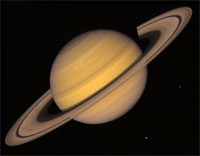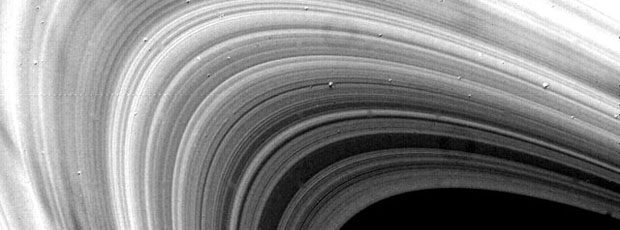 On the 12th of November 1980, NASA’s Voyager 1 probe had it’s closest encounter of Saturn, passing within 124,000 kilometres of the planet. Earlier during the same day, Voyager had also come within an incredible 4,000 kilometres of Saturn’s largest moon, Titan.
On the 12th of November 1980, NASA’s Voyager 1 probe had it’s closest encounter of Saturn, passing within 124,000 kilometres of the planet. Earlier during the same day, Voyager had also come within an incredible 4,000 kilometres of Saturn’s largest moon, Titan.
Today, we’ll celebrate one of modern times most historic explorers – Voyager 1 – that 23 years ago helped reveal so much about the planet Saturn and its many moons.
The Incredible Journey
The spacecraft Voyager 1 was launched from Florida on 5th September 1977 with an aim to reach Jupiter and Saturn for scientific study. Voyager 1 was originally built to last for five years so it could accomplish its two-planet mission.
In fact, it was possible for the spacecraft to travel much further afield. Remote-control technology was developed so that Voyager could travel further and for longer. Between Voyager 1 and 2, the twin spacecraft visited all the giant outer planets – as well as 48 moons!
Since 1977, Voyager 1 has sent incredible data back to earth for scientists to examine and has contributed greatly to the field of planetary astronomy. In 1998, it became the most distant human-made object in space and in August 2012, Voyager 1 made the historic entry into interstellar space, the region between stars to witness material formed by dying stars.
As of September 2013, Voyager 1 had officially left our solar system!
Close Encounters
Voyager 1’s twin, Voyager 2 passed even closer to Saturn on the 26th of August 1981 and witnessed several surprises in its planetary rings.

It’s thought that the rings formed when larger moons were shattered by impacts of comets and meteoroids; the resulting dust then accumulated around the planet. Unexpected structures such as kinks and spokes were found which haven’t been observed before from earth – most of these are thought to be caused by gravitational pull from nearby satellites/moons.
Saturn is made up of hydrogen and helium and it’s yellow colouring was found to have banding similar to that found on Jupiter. Close study by Voyager 1 also showed more ovals and other atmospheric features but on a smaller scale then those on Jupiter.
Fa-saturn-ating Facts
11,000 work-years were devoted to the Voyager project through the Neptune encounter alone (that’s about one third the amount of effort used to build the great pyramid at Giza!)
Voyager 1 and Voyager 2 have 69.63kb of memory each (so a 16gb iPhone 5 has about 240,000 times the memory of a Voyager spacecraft!)
Voyager 1 communicates with Earth through NASA’s Deep Space Network. A signal from the ground, travelling at the speed of light, takes 17 hours one way to reach the spacecraft!
Saturn is the second largest planet in the solar system. It takes 29.5 Earth years to complete one orbit of the Sun, and its day was clocked at 10 hours, 39 minutes.
